warning light Acura TL 2000 3.2 Owner's Manual
[x] Cancel search | Manufacturer: ACURA, Model Year: 2000, Model line: TL, Model: Acura TL 2000Pages: 311, PDF Size: 3.05 MB
Page 6 of 311
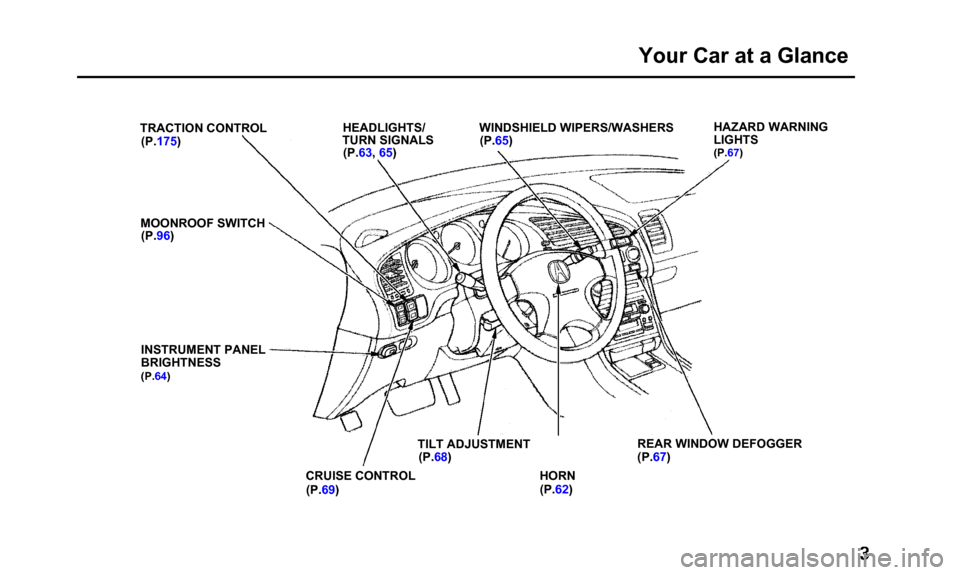
Your Car at a Glance
TRACTION CONTROL(P.175)
MOONROOF SWITCH (P.96)
INSTRUMENT PANEL
BRIGHTNESS
(P.64)
HEADLIGHTS/
TURN SIGNALS (P.63, 65) WINDSHIELD WIPERS/WASHERS
(P.65) HAZARD WARNING
LIGHTS
(P.67)
CRUISE CONTROL
(P.69) HORN
(P.62)
TILT ADJUSTMENT
(P.68) REAR WINDOW DEFOGGER
(P.67)
Page 54 of 311
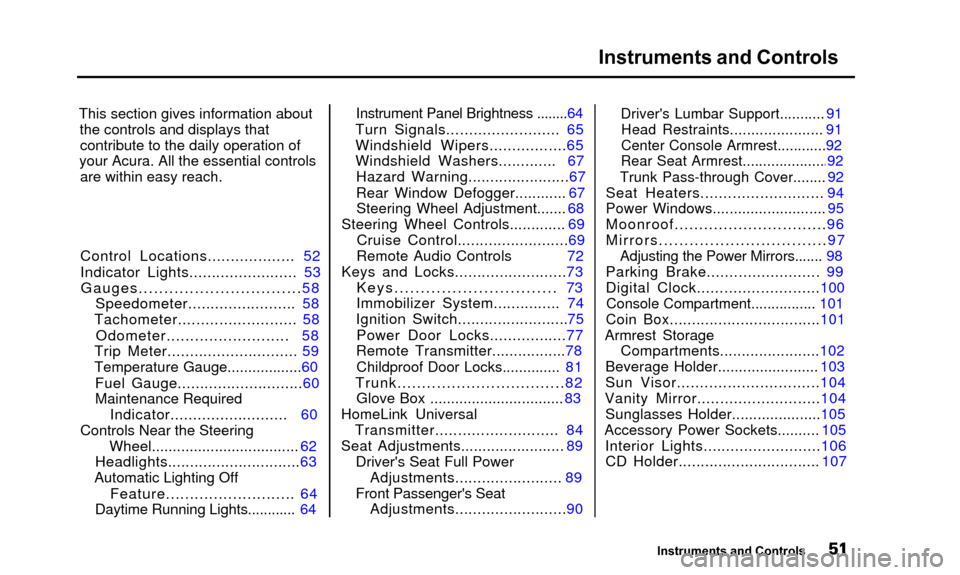
Instruments and Controls
This section gives information aboutthe controls and displays thatcontribute to the daily operation of
your Acura. All the essential controls are within easy reach.
Control Locations................... 52
Indicator Lights........................ 53
Gauges................................58
Speedometer........................ 58
Tachometer.......................... 58
Odometer.......................... 58
Trip Meter............................. 59
Temperature Gauge..................60
Fuel Gauge............................60
Maintenance Required Indicator.......................... 60
Controls Near the Steering
Wheel................................... 62
Headlights..............................63
Automatic Lighting Off
Feature........................... 64
Daytime Running Lights............ 64
Instrument Panel Brightness ........64
Turn Signals......................... 65
Windshield Wipers.................65
Windshield Washers............. 67 Hazard Warning....................... 67
Rear Window Defogger............ 67
Steering Wheel Adjustment....... 68
Steering Wheel Controls............. 69 Cruise Control.........................69
Remote Audio Controls 72
Keys and Locks.........................73
Keys............................... 73
Immobilizer System............... 74
Ignition Switch ......................... 75
Power Door Locks.................77
Remote Transmitter.................78
Childproof Door Locks.............. 81
Trunk.................................. 82
Glove Box ................................ 83
HomeLink Universal Transmitter........................... 84
Seat Adjustments........................ 89
Driver's Seat Full PowerAdjustments........................ 89
Front Passenger's Seat Adjustments.........................90
Driver's Lumbar Support........... 91Head Restraints...................... 91
Center Console Armrest............92
Rear Seat Armrest....................4 92
Trunk Pass-through Cover........ 92
Seat Heaters........................... 94
Power Windows........................... 95
Moonroof...............................96
Mirrors.................................97
Adjusting the Power Mirrors....... 98
Parking Brake......................... 99
Digital Clock...........................100
Console Compartment................ 101
Coin Box..................................101
Armrest Storage
Compartments.......................102
Beverage Holder........................ 103
Sun Visor...............................104
Vanity Mirror........................... 104
Sunglasses Holder.....................105
Accessory Power Sockets.......... 105
Interior Lights..........................106
CD Holder................................ 107
Instruments and Controls
Page 59 of 311
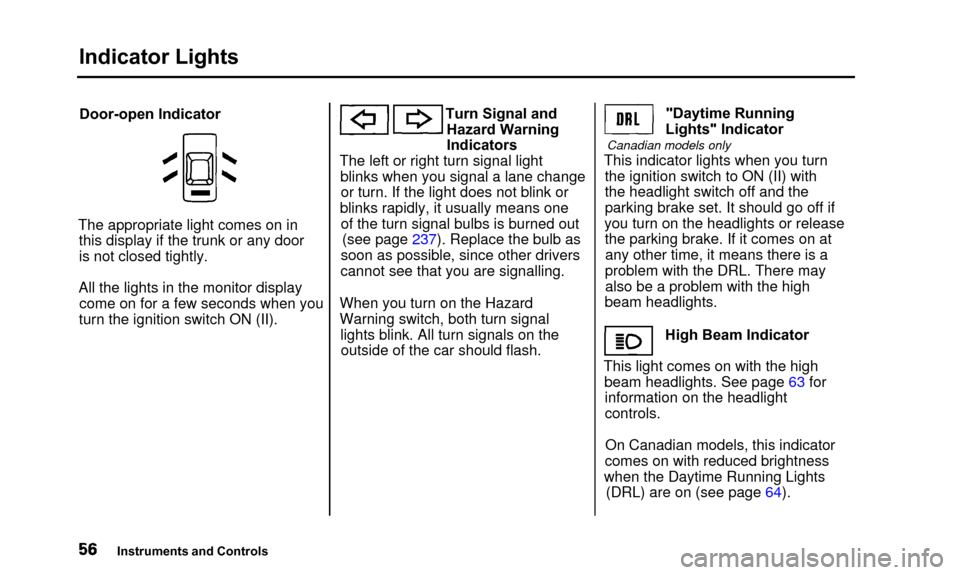
Indicator Lights
Door-open Indicator
The appropriate light comes on in this display if the trunk or any door
is not closed tightly.
All the lights in the monitor display come on for a few seconds when you
turn the ignition switch ON (II). Turn Signal and
Hazard Warning
Indicators
The left or right turn signal light blinks when you signal a lane changeor turn. If the light does not blink or
blinks rapidly, it usually means one of the turn signal bulbs is burned out (see page 237). Replace the bulb as
soon as possible, since other drivers
cannot see that you are signalling.
When you turn on the Hazard
Warning switch, both turn signal lights blink. All turn signals on theoutside of the car should flash. "Daytime Running
Lights" Indicator
Canadian models only
This indicator lights when you turn the ignition switch to ON (II) with
the headlight switch off and the
parking brake set. It should go off if
you turn on the headlights or release the parking brake. If it comes on atany other time, it means there is a
problem with the DRL. There may also be a problem with the high
beam headlights.
High Beam Indicator
This light comes on with the high beam headlights. See page 63 forinformation on the headlight
controls.
On Canadian models, this indicator
comes on with reduced brightness
when the Daytime Running Lights (DRL) are on (see page 64).
Instruments and Controls
Page 65 of 311
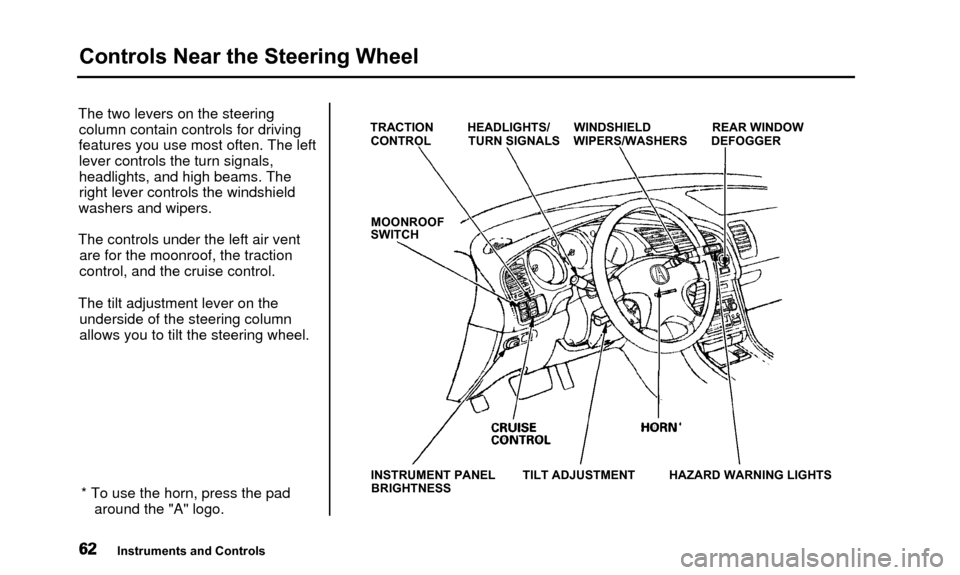
Controls Near the Steering Wheel
The two levers on the steeringcolumn contain controls for driving
features you use most often. The left lever controls the turn signals,
headlights, and high beams. The
right lever controls the windshield
washers and wipers.
The controls under the left air vent are for the moonroof, the traction
control, and the cruise control.
The tilt adjustment lever on the underside of the steering column
allows you to tilt the steering wheel.
* To use the horn, press the pad around the "A" logo.TRACTION HEADLIGHTS/ WINDSHIELD REAR WINDOW
CONTROL TURN SIGNALS WIPERS/WASHERS DEFOGGER
MOONROOF
SWITCH
INSTRUMENT PANEL TILT ADJUSTMENT HAZARD WARNING LIGHTS
BRIGHTNESS
Instruments and Controls
Page 70 of 311

Controls Near the Steering Wheel
Windshield WashersTo clean the windshield, pull back onthe wiper control lever. The washersspray until you release the lever. The
wipers run at low speed while you're pulling the lever, then complete one
more sweep of the windshield after
you release it. Hazard Warning
Push the red button to the right of
the clock to turn on the hazard
warning lights (four-way flashers).
This causes all four outside turn signals and both indicators in the
instrument panel to flash. Use the
hazard warning lights if you need to
park in a dangerous area near heavy
traffic, or if your car is disabled. Rear Window Defogger
The rear window defogger will clear fog, frost, and thin ice from the
window. Push the defogger button to turn it on and off. The light above
defogger is on. If you do not turn it
off, the defogger will shut itself off
after about 15 minutes. It also shuts
off when you turn off the ignition.
You have to turn it on again when
you restart the car.
CONTINUED
Instruments and Controls
Page 182 of 311

Driving in Bad Weather
Visibility — Being able to seeclearly in all directions and being
visible to other drivers are important in all weather conditions. This is
more difficult in bad weather. To be
seen more clearly during daylight
hours, turn on your headlights.
Inspect your windshield wipers and
washers frequently. Keep the wind- shield washer reservoir full of theproper fluid. Have the windshield
wiper blades replaced if they start to streak the windshield or leave parts
unwiped. Use the defroster and air
conditioning to keep the windows
from fogging up on the inside (see pages 112 and 118). Traction — Check your tires
frequently for wear and properpressure. Both are important in
preventing "hydroplaning" (loss of
traction on a wet surface). In the
winter, mount snow tires on all four
wheels for the best handling.
Watch road conditions carefully, they can change from moment tomoment. Wet leaves can be as slip-
pery as ice. "Clear" roads can have
patches of ice. Driving conditions
can be very hazardous when theoutside temperature is near freezing.
The road surface can become covered with areas of water puddlesmixed with areas of ice, so your
traction can change without warning.
Be careful when downshifting. If
traction is low, you can lock up the
drive wheels for a moment and cause
a skid. Be very cautious when passing, or
being passed by other vehicles. The spray from large vehicles reduces
your visibility, and the wind buffeting can cause you to lose control.
Driving
Page 258 of 311

Changing a Flat Tire
If you have a flat tire while driving,stop in a safe place to change it.
Stopping in traffic or on the shoulder
of a busy road is dangerous. Driveslowly along the shoulder until you
get to an exit or an area to stop that
is far away from the traffic lanes.
The car can easily roll off the
jack, seriously injuring anyone underneath.
Follow the directions for
changing a tire exactly, and never get under the car when it
is supported only by the jack.HOOK
SPARE TIRE TOOL BOX
1. Park the car on firm, level, and non-slippery ground away from
traffic. Put the transmission inPark. Apply the parking brake.
2. Turn on the hazard warning lights and turn the ignition switch to
LOCK (0). Have all the
passengers get out of the car while
you change the tire. 3. Open the trunk. Raise the trunk
floor by lifting up on the back edge.
To keep the trunk floor out of the way, attach the hook into the slot in the trunk lid.
4. Unscrew the wing bolt and take the spare tire out of its well.
5. The tools are in the tool box on the right side of the trunk. Takethe tools out of the tool box.
CONTINUED
Taking Care of the Unexpected
TRUNK FLOOR
JACK
Page 265 of 311

If Your Engine Won't Start, Jump Starting
The Starter Operates NormallyIn this case, the starter motor's
speed sounds normal, or even faster
than normal, when you turn the
ignition switch to START (III), but
the engine does not run.
• Your car has the Immobilizer System. You should use a
properly-coded master or valet key
to start the engine (see page 74).
A key that is not properly coded will cause the immobilizer systemindicator in the dash panel to blink
rapidly.
• Are you using the proper starting procedure? Refer to Starting theEngine on page 161.
• Do you have fuel? Turn the
ignition switch to ON (II) for a
minute and watch the fuel gauge.
The low fuel level warning light may not be working, so you were
not reminded to fill the tank.
• There may be an electrical problem, such as no power to the
fuel pump. Check all the fuses (see page 273).
If you find nothing wrong, you will
need a qualified technician to find
the problem. See Emergency
Towing on page 277. Jump Starting
If your car's battery has run down,
you may be able to start the engine by using a booster battery. Although
this seems like a simple procedure,
you should take several precautions.
A battery can explode if you donot follow the correct procedure,
seriously injuring anyone nearby.
Keep all sparks, open flames,
and smoking materials away
from the battery.
You cannot start your Acura by pushing or pulling it.
Taking Care of the Unexpected
Page 270 of 311
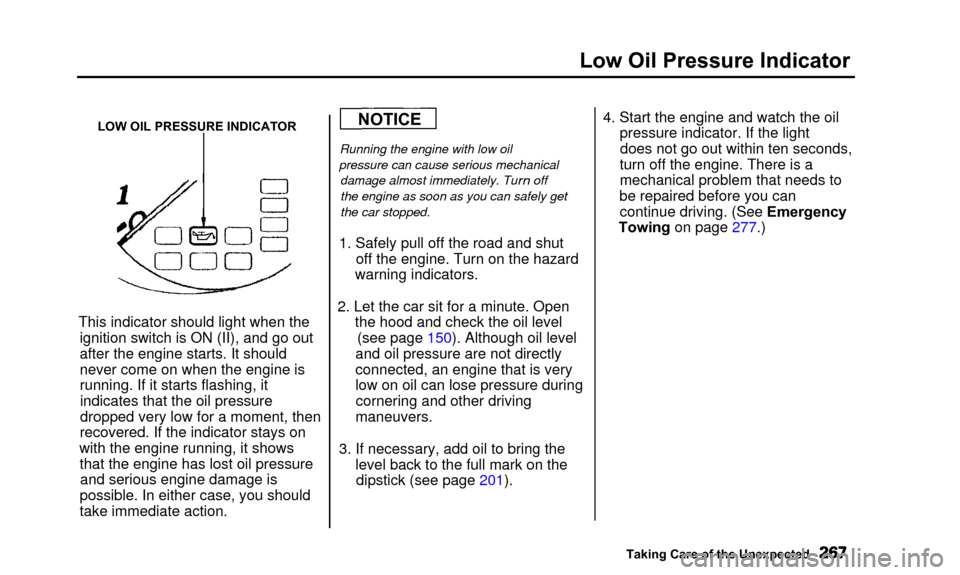
Low Oil Pressure Indicator
LOW OIL PRESSURE INDICATOR
This indicator should light when theignition switch is ON (II), and go out
after the engine starts. It should
never come on when the engine is
running. If it starts flashing, itindicates that the oil pressure
dropped very low for a moment, then
recovered. If the indicator stays on
with the engine running, it shows that the engine has lost oil pressureand serious engine damage is
possible. In either case, you should
take immediate action.
Running the engine with low oil
pressure can cause serious mechanical damage almost immediately. Tu
rn off
the engine as soon as you can safely get
the car stopped.
1. Safely pull off the road and shut off the engine. Turn on the hazard
warning indicators.
2. Let the car sit for a minute. Open the hood and check the oil level(see page 150). Although oil level
and oil pressure are not directly
connected, an engine that is very
low on oil can lose pressure during cornering and other driving
maneuvers.
3. If necessary, add oil to bring the level back to the full mark on thedipstick (see page 201). 4. Start the engine and watch the oil
pressure indicator. If the lightdoes not go out within ten seconds,
turn off the engine. There is a
mechanical problem that needs to
be repaired before you can continue driving. (See Emergency
Towing on page 277.)
Taking Care of the Unexpected
NOTICE
Page 305 of 311
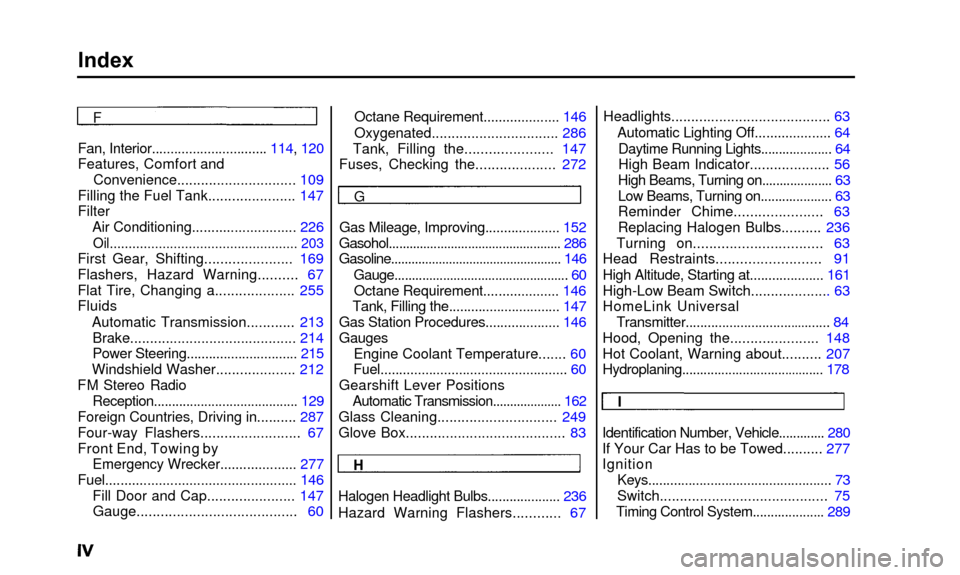
Index
Fan, Interior............................... 114, 120
Features, Comfort andConvenience.............................. 109
Filling the Fuel Tank...................... 147
Filter Air Conditioning.......... ................. 226
Oil.................................................. 203
First Gear, Shifting.......... ............ 169
Flashers, Hazard Warning.......... 67
Flat Tire, Changing a.................... 255
Fluids
Automatic Transmission.. .......... 213
Brake.......... ................................ 214
Power Steering.............................. 215
Windshield Washer.................... 212
FM Stereo Radio Reception........................................ 129
Foreign Countries, Driving in.......... 287
Four-way Flashers......................... 67
Front End, Towing by
Emergency Wrecker.................... 277
Fuel.................................................. 146
Fill Door and Cap...................... 147 Gauge........................................ 60 Octane Requirement..........
.......... 146
Oxygenated.......... ...................... 286
Tank, Filling the.......... ............ 147
Fuses, Checking the.......... .......... 272Headlights.......................................
. 63
Automatic Lighting Off.................... 64 Daytime Running Lights......... ........... 64
High Beam Indicator.................... 56
High Beams, Turning on......... ........... 63
Low Beams, Turning on......... ........... 63
Reminder Chime...................... 63
Replacing Halogen Bulbs.......... 236
Turning on......... ....................... 63
Head Restraints.......................... 91
High Altitude, Starting at.......... .......... 161
High-Low Beam Switch......... ........... 63
HomeLink Universal Transmitter.............................
.......... . 84
Hood, Opening the...................... 148
Hot Coolant, Warning about.......... 207
Hydroplaning.............................
........... 178
F
G
Gas Mileage, Improving.......... .......... 152
Gasohol.................................................. 286
Gasoline.................................................. 146
Gauge......... ........................................ . 60
Octane Requirement.......... .......... 146
Tank, Filling the.......... .................... 147
Gas Station Procedures.................... 146
Gauges
Engine Coolant Temperature... .... 60
Fuel................................................. . 60
Gearshift Lever Positions Automatic Transmission.................... 162
Glass Cleaning.............................. 249
Glove Box....................................... . 83
H
Halogen Headlight Bulbs.................... 236
Hazard Warning Flashers.......... .. 67I
Identification Number, Vehicle............. 280
If Your Car Has to be Towed.......... 277
Ignition
Keys................................................. . 73
Switch......................................... . 75
Timing Control System.......... .......... 289